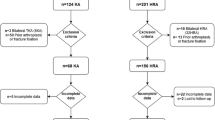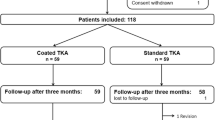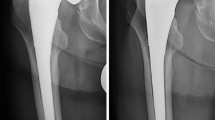Abstract
Introduction
Metal-on-metal (MoM) hip replacement bearings produce metallic ions that can cause health complications. Metallic release also occurs with other materials, but data on metallic ion levels after knee arthroplasty are sparse. We postulate that knee replacement generates elevating metallic ions (chromium (Cr), cobalt (Co) and titanium (Ti)) during the first year after implantation.
Patients and methods
This ongoing prospective study included all patients who underwent the same type of knee arthroplasty between May and December 2013. Cr, Co and Ti levels were measured in whole blood at pre-operation and one-year follow-up (6 and 12 months). Clinical and radiographic data (range of motion, Oxford, International Knee Society (IKS) and satisfaction scores) were recorded.
Results
In 90 patients, preoperative Cr, Co and Ti metallic ion levels were respectively 0.45 μg/l, 0.22 μg/l, 2.94 μg/l and increased to 1.27 μg/l, 1.41 μg/l, 4.08 μg/l (p < 0.0001) at last one-year follow-up. Mean Oxford and IKS scores rose, respectively, from 45.9 (30–58) and 24.9 (12–52) to 88.3 (0–168) and 160.8 (93–200) (p < 0.001).
Conclusion
After the implantation of knee arthroplasty, we found significant blood elevation of Cr, Co and Ti levels one year after implantation exceeding the normal values. This metallic ion release could lead to numerous effects: allergy, hypersensitivity, etc.
Similar content being viewed by others
Avoid common mistakes on your manuscript.
Introduction
Metal alloys implanted in the body corrode over time and can trigger systemic metallic ion release [8]. In this respect, total knee arthroplasties (TKA) and total hip arthroplasties (THA) with metal-on-metal (MoM) bearings, paediatric knee prostheses and spinal procedures all raise questions about metallic ion transition in blood [1, 4, 19,20,21]. Some MoM THA configurations have been correlated with high chromium (Cr), cobalt (Co) and titanium (Ti) levels, local adverse reactions (adverse reaction metal debris (ARMD), pseudotumors, Aseptic Lymphocyte-dominated Vasculitis-Associated Lesion (ALVAL), etc.) [1, 4, 17, 19,20,21]. Besides local lesions, their release could be involved in systemic allergic reactions (hypersensitivity, skin reactions) [13].
Unlike MoM THA, polyethylene interfaces are present in TKA configurations, avoiding MoM contact. However, their large metallic surfaces are potentially prone to passive corrosion by synovial fluid [10]. In addition, femoral and tibial stems with Morse tapers induce MoM junctions which could release metallic ions [3].
The purpose of this study was to analyze metallic ion release in blood after knee arthroplasty implantation in a prospective series with pre- and post-operative biological analysis. The main hypothesis was the observation of an elevation of metallic ions levels after knee arthroplasty. The second one was the lack of correlation between the ions release and the clinical scores. The last one was the lack of correlation between the ions release and the metallic alloy volume of knee arthroplasty.
Materials and methods
Patients
A single-centre, prospective study was conducted between May and December 2013. Patient consent was obtained systematically before surgery. The inclusion criterion was: adult patients undergoing TKA from 1 manufacturer (Zimmer®) for primary osteoarthritis. The femoral component of Legacy Posterior Stabilized® LPS / Unicondylar ZUC®/ Legacy Constrained Condylar Knee ® LCCK / Rotating Hinge Knee® RHK models is a Cr-Co alloy (Zimaloy®). The tibial component of LPS/ ZUC/ LCCK models is a titanium alloy (Ti-Al6 Tivanium-V4). The tibial component of the RHK model is a Co-Cr alloy. Extension stems are of Ti alloy (Titanium Al6-V4; Table 1). Both components are cemented.
Exclusion criteria were: patients with another articular prosthesis, TKA implantation from another manufacturer, occupational exposure to toxic metals (industrial paints, solvents) and protocol non-acceptance.
Evaluation criteria
Blood samples were drawn from all patients on the day of surgery, before TKA implantation. During follow-up, blood specimens were taken six and 12 months after surgery. Co and Cr levels were measured by inductively-coupled plasma mass spectrometry (MS) with collision cell to eliminate spectroscopic interference. Ti was evaluated by Varian 820 MS (Bruker, Wissembourg, France). Whole blood was analyzed via type BD Vacutainer needle (Eclipse blood collection needle). The detection limit was 0.05 μg/l, and the quantification limit was 0.1 μg/l [11]. The normal detectables values for chromium, cobalt and titanium levels were respectively inferior to 0.5 μg/l, 0.5 μg/l and 4 μg/l and were defined as outlier biological values [11].
Clinical evaluation was based on Oxford Knee Score [9] and International Knee Society (IKS) [7] scores, preoperatively, and at six and 12 months. Bipodal orthopantograms X-rays were evaluated for mechanical hip knee angle (HKA) and tibial slope on lateral views pre- and post-operatively. TKA implant migration was verified according to the criteria and areas described by the International Knee Society, to ascertain prosthetic failure and/or excessive blood levels of metallic ions [2].
Statistical analysis
The kinetics of Cr, Co and Ti levels were assessed in a linear mixed model. Correlations between metallic ions on the first day (day 0) and at last follow-up with different factors were investigated by linear regression (adjusted to day 0 metallic ion levels). The evolution of clinical parameters from the day 0 to last follow-up was analyzed by Student’s t-test or Wilcoxon matched pairs signed rank test. Statistics were processed by SAS 9.4 software (SAS Institute, Cary, NC, USA) with significance level of 5%.
Results
On the 144 patients included according to the inclusion criteria, 54 were excluded because of another articular prosthesis pre-operatively (50 patients) and protocol refusal (4 patients). This left 90 patients (90 implants) included for analysis. No patient was lost to follow-up, and no deaths occurred during the follow-up period. Of these 90 patients, 8 underwent unicompartmental knee arthroplasties (Group 1), 66 posterior-stabilized knee arthroplasties (Group 2) and 16 intramedullary stem knee arthroplasties (LCCK or RHK; Group 3). Our series included 65 women and 25 men with average age of 66.2 years (39–89) (Table 2). No metal or jewelry skin allergy to nickel, Cr, Co or Ti was found. The mean metallic ions levels were under the normal detectables values.
All clinical parameters were improved at last follow-up (Table 3). Mean Oxford score increased from 45.9 to 24.9 (p < 0.0001). Overall IKS score went from 88.3 to 160.8 (p < 0.0001). Average knee flexion improved by 8.7° (109.2° to 117.9°) (p < 0.0001).
Pre- and post-operative HKA angles mostly showed well-axed knees pre-operatively as well as post-operatively. Angle normalization was observed (p = 0.01). Knees in group 2 patients were more often in varus pre-operatively (HKA 176.2°) and became oriented with normal axis post-operatively (178.4°).
Average pre-operative Cr, Co and Ti blood levels were, respectively, 0.45 μg/l, 0.22 μg/l and 2.94 μg/l. At post-operative year one, they increased, respectively, to 1.27 μg/l, 1.41 μg/l and 4.08 μg/l (p < 0.0001) exceeding the normal values (Table 4 and Fig. 1). At one post-operative year, the percentages of outliers’ values were, respectively, for chromium, cobalt and titanium 83%, 76% and 19%.
None of the following parameters was significantly correlated with metallic ion release: kidney function, age, body mass index (BMI), prosthetic volume implanted, intramedullary stems, implant size, post-operative HKA angle, and clinical knee scores (Oxford and IKS). No correlation was found between increased average metallic ion levels and the three patient groups.
Discussion
The evolution of metallic ion levels (Cr, Co and Ti) after MoM THA implantation is well-known [19]. However, other types of orthopaedic surgery can also lead to metal release: Maverick lumbar disc prostheses [5], spinal hardware [1], etc. Similarly, ion release appears to be very significant after TKA implantation, regardless of implanted arthroplasty type [5, 18]. Pre-operative rates were the strength of our study, making follow-up analysis very relevant.
Nevertheless, our study has several limitations. Study population size was quite low (90 cases). However, to our knowledge, it is the largest series of its kind. On the other hand, it is directly related to the fact that more than 50% of patients operated during the inclusion period were excluded from the study. Also, we wanted to analyse only one type of metal alloy from a single manufacturer to obtain consistent results. In addition, we excluded previous arthroplasty patients to avoid blood levels being impacted by other metallic implants. Our follow-up was short. However, the one-year follow-up period seems sufficient to avoid the implant run-in phase and obtain metallic levels considered as stable over time [5, 6].
In 1989, Sunderman et al. [16] reported a significant rise in metallic ion blood levels three months after TKA implantation compared to healthy subjects. Their finding was confirmed by Luetzner et al. [12]; as in our study, no correlation between the evolution of metallic ions and BMI or physical activity was found. Our work confirms that metallic ion release is not correlated with metallic volume implanted. A similar observation was made by Luetzner et al. [12] who did not discern any metallic ion level difference after one- or two-knee arthroplasty. Mean Cr and Co concentrations were, respectively, 0.92 μg/l and 3.28 μg/l in the unilateral TKA group and 0.98 μg/l and 4.28 μg/l in bilateral TKA.
Friesenbichler et al. [4] reported increased metallic ion release in patients who underwent knee megaprosthesis compared to patients assigned to hinge TKA. Their hypothesis was based on wide, passive corrosion of the femoral component by synovial fluid. Other teams have suggested that Morse taper junction stems may be responsible for elevated ion release [4, 14]. In our series, we did not encounter significant differences between the average metallic ion release rate and TKA type. The low numbers of patients with intramedullary stems could explain this result. Another possible reason is the non-articular location of the stems [14]. Although mobility and corrosion were seen in Morse taper junction stems, it was unlikely that blood ion elevation was impacted. Moreover, no correlation was noted between metallic alloy volume (uniKA or TKA) and ions release.
Currently, there seems to be considerable diagnostic interest in evaluating metallic ion levels because of painful TKA. Savarino et al. [15] ascertained significant Cr elevation in a patient group with painful TKA compared to healthy subjects. Similarly, pain after TKA, correlated with metal allergies, created significant diagnostic problems. To date, a real test to confirm this diagnosis does not exist. We believe that evaluation of blood metallic ions is an additional and informative tool to corroborate these allergic episodes. Intra-articular assessment might also be worthwhile. In this context, adequate monitoring of metallic ions in individual patients could be developed, especially for patients with proven pain but without evidence of loosening or other signs of prosthetic dysfunction.
It is noteworthy that only pre-operative evaluation will allow verification and confirmation of metallic ion elevation at follow-up. Indeed, our study demonstrates that pre-operative data on Cr, Co and Ti ions are highly variable from one patient to another. All the patients had detectable metallic levels like in the general population (within 0.5 μg/l for chromium and cobalt). The impact of metallic ion release is still unknown. However, the levels found in our study were very similar (or even higher) than those seen after metal hip resurfacing or MoM THA [11, 19, 20]. No complications related to metallic ion release were observed in our series.
Conclusion
After the implantation of knee arthroplasty, we found significant blood elevation of Cr, Co and Ti levels one year after implantation exceeding the normal values. Our prospective study, in which each patient was his/her own control (through pre-operative evaluation), discerned significant ion release similar to that after MoM THA. No correlation between ions release and clinical scores or metallic alloy volume were noticed.
References
Bisseling P, Zeilstra DJ, Hol AM, van Susante JL (2011) Metal ion levels in patients with a lumbar metal-on-metal total disc replacement: should we be concerned? J Bone Joint Surg Br 93:949–954
Ewald FC (1989) The knee society total knee arthroplasty roentgenographic evaluation and scoring system. Clin Orthop Relat Res 248:9–12
Friesenbichler J, Maurer-Ertl W, Sadoghi P, Lovse T, Windhager R, Leithner A (2012) Serum metal ion levels after rotating-hinge knee arthroplasty: comparison between a standard device and a megaprosthesis. Int Orthop 36:539–544
Friesenbichler J, Sadoghi P, Maurer-Ertl W, Szkandera J, Glehr M, Ogris K (2014) Serum metal ion concentrations in paediatric patients following total knee arthroplasty using megaprostheses. Biomed Res Int 2014:817257
Garrett S, Jacobs N, Yates P, Smith A, Wood D (2010) Differences in metal ion release following cobalt-chromium and oxidized zirconium total knee arthroplasty. Acta Orthop Belg 76:513–520
Granchi D, Cenni E, Giunti A, Baldini N (2012) Metal hypersensitivity testing in patients undergoing joint replacement: a systematic review. J Bone Joint Surg Br 94:1126–1134
Insall JN, Dorr LD, Scott RD, Scott WN (1989) Rationale of the knee society clinical rating system. Clin Orthop Relat Res 248:13–14
Jacobs JJ, Gilbert JL, Urban RM (1998) Corrosion of metal orthopaedic implants. J Bone Joint Surg Am 80:268–282
Jenny JY, Diesinger Y (2011) Validation of a French version of the Oxford knee questionnaire. Orthop Traumatol Surg Res 97:267–271
Leopold SS, Berger RA, Patterson L, Skipor AK, Urban RM, Jacobs JJ (2000) Serum titanium level for diagnosis of a failed, metal-backed patellar component. J Arthroplast 15:938–943
Lons A, Arnould A, Pommepuy T, Drumez E, Girard J (2015) Excellent short-term results of hip resurfacing in a selected population of young patients. Orthop Traumatol Surg Res 101:661–665
Luetzner J, Krummenauer F, Lengel AM, Ziegler J, Witzleb WC (2007) Serum metal ion exposure after total knee arthroplasty. Clin Orthop 461:136–142
Mahendra G, Pandit H, Kliskey K, Murray D, Gill HS, Athanasou N (2009) Necrotic and inflammatory changes in metal-on-metal resurfacing hip arthroplasties. Acta Orthop 80:653–659
McMaster WC, Patel J (2013) Adverse local tissue response lesion of the knee associated with Morse taper corrosion. J Arthroplast 28:375
Savarino L, Tigani D, Greco M, Baldini N, Giunti A (2010) The potential role of metal ion release as a marker of loosening in patients with total knee replacement: a cohort study. J Bone Joint Surg Br 92:634–638
Sunderman FW, Hopfer SM, Swift T, Rezuke WN, Ziebka L, Highman P (1989) Cobalt, chromium, and nickel concentrations in body fluids of patients with porous-coated knee or hip prostheses. J Orthop Res 7:307–315
Sutphen SA, MacLaughlin LH, Madsen AA, Russell JH, McShane MA (2016) Prevalence of pseudotumor in patients after metal-on-metal hip arthroplasty evaluated with metal ion analysis and MARS-MRI. J Arthroplast 31:260–263
Takai S, Yoshino N, Kusaka Y, Watanabe Y, Hirasawa Y (2003) Dissemination of metals from a failed patellar component made of titanium-base alloy. J Arthroplast 18:931–935
Vendittoli PA, Roy A, Mottard S, Girard J, Lusignan D, Lavigne M (2010) Metal ion release from bearing wear and corrosion with 28 mm and large-diameter metal-on-metal bearing articulations: a follow-up study. J Bone Joint Surg Br 92:12–18
Vendittoli PA, Amzica T, Roy AG, Lusignan D, Girard J, Lavigne M (2011) Metal ion release with large-diameter metal-on-metal hip arthroplasty. J Arthroplast 26:282–288
Zeh A, Becker C, Planert M, Lattke P, Wohlrab D (2009) Time-dependent release of cobalt and chromium ions into the serum following implantation of the metal-on-metal maverick type artificial lumbar disc (Medtronic Sofamor Danek). Arch Orthop Trauma Surg 129:741–746
Author information
Authors and Affiliations
Corresponding author
Ethics declarations
Conflict of interest
The authors declare that they have no conflict of interest.
Funding
There is no funding source.
Ethical approval
This article does not contain any studies with human participants or animals performed by any of the authors.
Informed consent
Informed consent was obtained from all individual participants included in the study.
Rights and permissions
About this article
Cite this article
Lons, A., Putman, S., Pasquier, G. et al. Metallic ion release after knee prosthesis implantation: a prospective study. International Orthopaedics (SICOT) 41, 2503–2508 (2017). https://doi.org/10.1007/s00264-017-3528-9
Received:
Accepted:
Published:
Issue Date:
DOI: https://doi.org/10.1007/s00264-017-3528-9





